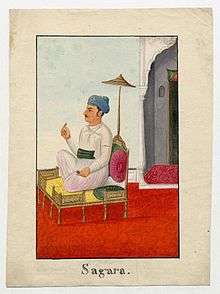King Sagara
| Sagara | |
|---|---|
 Sagar, a Vedic King and ancestor of Rama | |
| Information | |
| Spouse(s) | Sumati, Bhadra, Amba |
| Children | Asamanja |
In Hindu mythology, Sagara (Sanskrit: सगर; IAST: Sagara) is a prominent king of the Suryavansha dynasty in Satya Yuga. He has two wives, one a princess of the Vidarbha, and the other from royal lineage of Sivi,[1] and is an ancestor to Bhagiratha, Dasharatha and Rama.
Birth of Ganga
King Sagara performed a horse sacrifice (Ashwamedha yajna) to prove his supremacy. Lord Indra, the leader of the demigods, became fearful over the results of the yajna, so he decided to steal the horse. He left the horse at the ashram of Kapila, who was in deep meditation. King Sagar’s 60,000 sons, (born of Queen Sumati), and his son Asamanja (born of Queen Amba(Mahabharata)) were then sent to find the horse. When the 60,000 sons found the horse at Kapiladeva’s ashram, they thought he had stolen it. When they prepared to attack the meditating rishi (sage), Kapila opened his eyes. Because the sons of King Sagara had disrespected such a great personality, consequently, fire emanated from their own bodies, and they were immediately burned to ashes.[2]
Jain Tradition

In Jain tradition, Sagara was younger brother of Lord Ajitanatha (second Tirthankara).[3] He was born to Kshatriya King Sumitra and Queen Vijayanti (Yasomati) of Ikshvaku dynasty in Ayodhya.[3] He was the second Chakravartin ruler of the present half time cycle (Avasarpini) of Jain cosmology who conquered the world with his seven jewels.[4] His queens were Sumati and Bhadra.[3] He had sixty-thousand sons from his queens, Janhu being the eldest. Janhu flooded the Naga Kingdom with waters of river Ganga. This infuriated the Naga King who burnt all the sons of Sagara in anger. Sagara then place Bhagiratha, his grandson, on throne and left for penance.[5][6]
See also
Notes
- ↑ Ikshaku tribe The Mahabharata translated by Kisari Mohan Ganguli (1883 -1896), Book 3: Vana Parva: Tirtha-yatra Parva: Section CVI, p. 228 'There was born in the family of the Ikshaku tribe, a ruler of the earth named Sagar, endued with beauty, and strength...".
- ↑ Sons of Sagara Vishnu Purana translated by Horace Hayman Wilson, 1840, Book IV, Chapter IV. p. 378 the gods repaired to the Muni Kapila, who was a portion of Vishńu, free from fault, and endowed with all true wisdom. Having approached him with respect, they said, "O lord, what will become of the world, if these sons of Sagara are permitted to go on in the evil ways which they have learned from Asamanja! Do thou, then, assume a visible form, for the protection of the afflicted universe." "Be satisfied," replied the sage, "in a brief time the sons of Sagara shall be all destroyed."
- 1 2 3 Umakant P. Shah 1987, p. 72.
- ↑ Jacobi 2015, p. 199.
- ↑ McKay 2013, p. 151.
- ↑ von Glasenapp 1999, p. 298.
References
- Jacobi, Hermann (22 July 2015), The Uttarādhyayana Sūtra, Kshetra Books, ISBN 978-1515192145
- McKay, Alex (16 December 2013), Pilgrimage in Tibet, Routledge, ISBN 0-7007-0992-4
- von Glasenapp, Helmuth (1 January 1999), Jainism: An Indian Religion of Salvation, Delhi: Motilal Banarsidass, ISBN 81-208-1376-6
- Shah, Umakant P. (1987), Jaina-rūpa-maṇḍana: Jaina iconography, Abhinav Publications, ISBN 81-7017-208-X
Further reading
- Mani, Vettam (1975). Puranic Encyclopaedia. Motilal Banarsidass. pp. 662–663. ISBN 0842608222.
- Dowson, John (1888). A Classical Dictionary of Hindu Mythology and Religion, Geography, History and Literature. Ludgate Hill: Trubner & Co. pp. 271–272.
